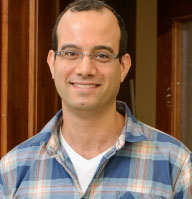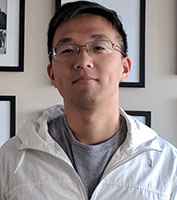Overview
[ Français ]
Online conferences from October 1 - October 8, 2021
Bo’az Klartag, Weizmann Institute of Science

Biography: Professor Bo’az Klartag is one of the world leading researchers in geometric analysis. He obtained his Ph.D. at Tel Aviv University in 2004, which he later joined as a professor. Professor Klartag is well known for his fundamental contributions to the field of asymptotic geometric analysis and, in particular, to the study of high-dimensional phenomena. In recognition of his outstanding accomplishments, Professor Klartag was invited to speak at the 2006 ICM in Madrid, and has been awarded the 2008 European Mathematical Society Prize as well as the 2010 Erdös Prize. He is currently professor at the Weizmann Institute of Science.
Title: Convexity and High-Dimensional Phenomena
.Video of the presentation
Online October 1, 2021 at 11am
This lecture is aimed at a general mathematical audience.
Abstract: High-dimensional problems with a geometric flavor appear in a number of branches of mathematics and mathematical physics. A priori, it seems that the immense diversity observed in high dimensions would make it impossible to formulate general, interesting theorems that apply to large classes of high-dimensional geometric objects. In this talk we will discuss situations in which high dimensionality, when viewed correctly, induces remarkable order and simplicity rather than complication. For example, Dvoretzky's theorem demonstrates that any high-dimensional convex body possesses nearly-Euclidean sections of large dimension. Another example is the central limit theorem for convex bodies, according to which any high-dimensional convex body has approximately-Gaussian marginals. There are strong motifs in high-dimensional geometry, such as the concentration of measure, which appear to compensate for the large number of different configurations. Convexity allows us to harness these motifs in order to formulate elegant and non-trivial theorems.
Title: Isoperimetry in convex bodies and Eldan's stochastic localization
.Video of the presentation
Online October 5, 2021 at 11am
Abstract: The Kannan-Lovasz-Simonovits (KLS) conjecture is concerned with the isoperimetric problem in high-dimensional convex bodies. The problem asks for the optimal way to partition a convex body into two parts of equal volume so as to minimize their interface. The conjecture suggests that up to a universal constant, the optimal solution is obtained by bisecting the convex body with a hyperplane. Some years ago it was proven that the KLS conjecture implies Bourgain's slicing conjecture. Recently, Chen has made significant progress towards the KLS conjecture, which utilizes the technique of Stochastic Localization by Eldan. In this lecture we will explain this method, and survey various results on isoperimetry and spectral gap under convexity assumptions.
Yuansi Chen, Duke University

Biography: A graduate of École Polytechnique in Paris, Dr. Yuansi Chen obtained his PhD in Statistics at UC Berkeley in 2019. After a postdoctoral fellowship in Data Science at ETH Zürich, Dr. Yuansi joined last year the faculty of the Department of Statistical Science at Duke University. While a researcher in Zürich, he made huge progress in a 25 year old conjecture proposed by Kannan, Lovász and Simonovits. It is a major breakthrough with many implications for central questions ranging from statistics and computer science to high-dimensional geometry, where the resolution of the KLS conjecture provides an answer to the slicing problem posed by Bourgain.
Title: Recent progress on the Kannan-Lovasz-Simonovits (KLS) conjecture and Bourgain's slicing problem I
.Video of the presentation
Online October 6, 2021 at 11am
Abstract: Kannan, Lovász, and Simonovits (KLS) conjectured in 1995 that the Cheeger isoperimetric coefficient of any log-concave density or any convex body is achieved by half-spaces up to a universal constant factor. This conjecture now plays a central role in the field of convex geometry, unifying or implying older conjectures. In particular, it implies Bourgain's slicing conjecture (1986) and the thin-shell conjecture (2003). While it is natural to expect convex bodies to have good isoperimetry (in other words, not look like dumbbells), the progress on bringing down the Cheeger isoperimetric coefficient in the KLS conjecture has been stagnant in recent years. The previous best bound, with dimension dependency d^1/4, was established by Lee and Vempala in 2017 using Eldan's stochastic localization, and matches the best dimension dependency Klartag obtained in 2006 for Bourgain's slicing conjecture.
After becoming familiar with Eldan's stochastic localization technique in the previous lecture, first we aim to get familiar with the concept of "localization" and to view stochastic localization as an extension. Then we go through the Lee and Vempala (2017) proof to see in action a concrete application of stochastic localization.
Title: Recent progress on the Kannan-Lovasz-Simonovits (KLS) conjecture and Bourgain's slicing problem II
.Video of the presentation
Online October 8, 2021 at 11am
This lecture is aimed at a general mathematical audience.
Abstract: In recent work, Chen (2020) improved Eldan's stochastic localization proof technique, which was deployed in Lee and Vempala (2017), to prove an almost constant Cheeger isoperimetric coefficient in the KLS conjecture with dimension dependency d^o(1). Consequently, his proof also provides a substantial advance toward the resolution of Bourgain's slicing conjecture and the thin-shell conjecture.
After getting conformable with Eldan's stochastic localization technique, in this talk we navigate through how to refine the technique to provide the current best bound. We will complete the self-contained proof of Chen (2020) and highlight the new ideas involved. Finally, we will discuss some extensions and provide an outlook for future research directions.